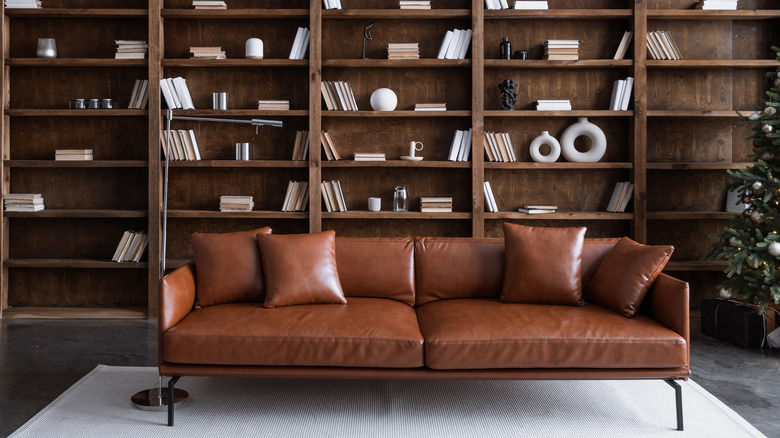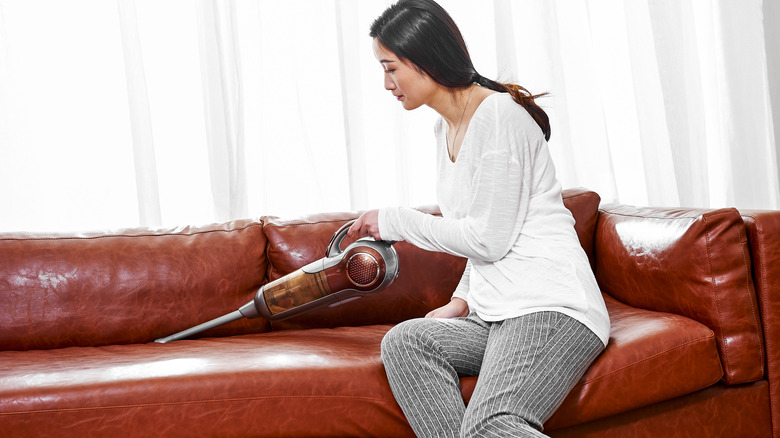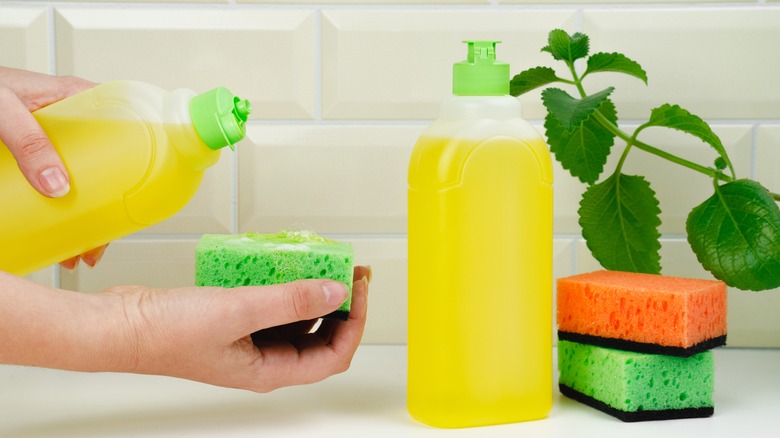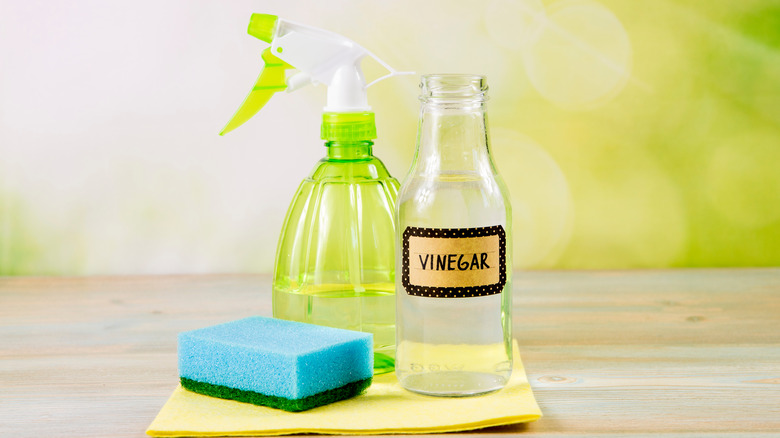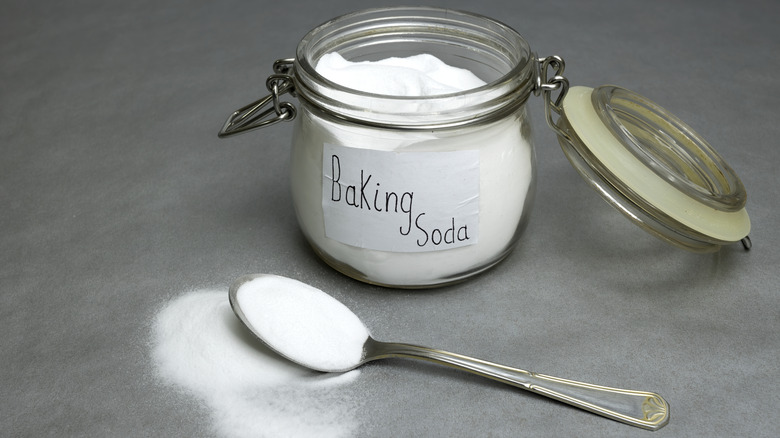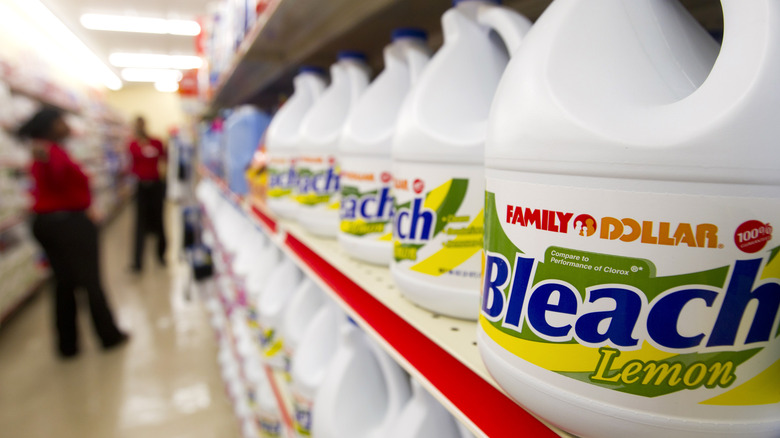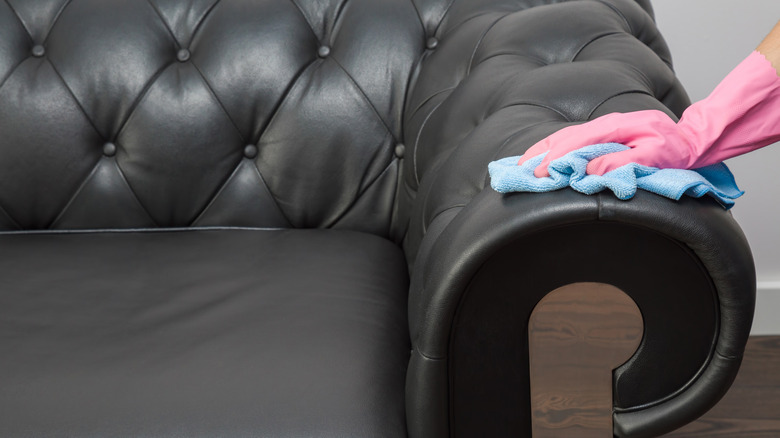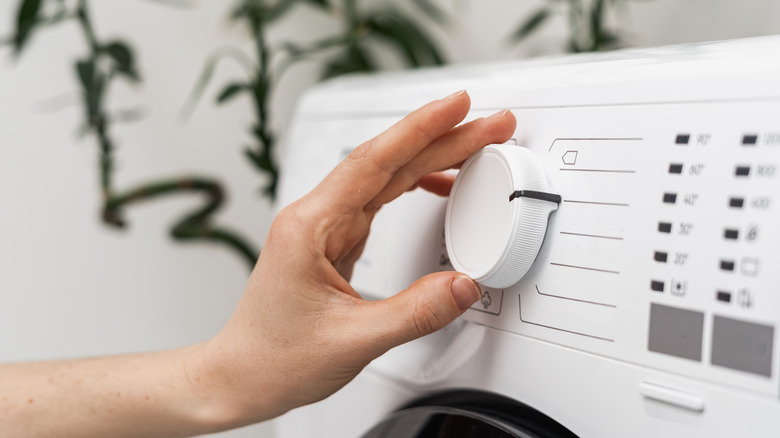Best Ways To Clean Faux Leather Furniture
The sleek, modern, and timeless look of leather furniture is very appealing for a variety of home decor aesthetics. Leather is also much easier to clean than other textiles like cotton, velvet, or canvas, and is ideal for people with pets and children. That being said, many people may not like the high cost associated with genuine leather furniture, or may not support leather production for personal reasons. Luckily, faux leather furniture is much cheaper than real leather, easier to look after, and no animals need to be hurt in the process!
When it comes to cleaning faux leather, though, you may be confused about what you should do. Leather needs very specific cleaning products, however, these can damage the plastics used in faux leather. Faux leather is made up of one of three materials, either silicone, polyurethane (PU), polyvinyl chloride or vinyl (PVC) according to Mitchell Faux Leathers. Whichever type of material your faux leather furniture is made out of will determine how best you should clean it, although most methods are gentle enough for all three.
1. Vacuum
The best way to avoid further damage or stains from developing on your faux leather furniture is to have a routine and regular cleaning schedule. According to Housewife How-To's, built-up dirt and debris on your faux leather furniture is one of the major causes of scratches.
To keep it from getting too scratched, you should try and vacuum your furniture once a week. Use the soft brush on all your cushions and the structured part of the furniture itself, being careful not to rub anything too hard and cause damage. Seams and other areas should be run over with the thinner crevice attachment. Make sure to take off all cushions you can on couches, loveseats, and chairs. If there are any visible messes besides dirt, dust, or debris, wipe them off or treat them separately. If you're concerned about the durability of your faux leather, check the label for further instructions.
2. Dish soap and water
Leather furniture has an advantage in the sense that there are a lot more cleaning products readily available at the store, making it as easy as applying it to a cloth and wiping down your furniture. These products are not recommended for use on faux leather, though. As Leather Care & Repair explains, faux leather is sensitive, and putting a strong cleaning solvent can cause it to dry and crack.
There's no need to reinvent the wheel, though — simple dish soap and water work wonders for cleaning your faux leather furniture, according to Red Hanger Cleaners. Spot-test your furniture before cleaning any big stains so you don't accidentally ruin the material. Simply mix gentle dish soap with warm water and apply it with a cloth, you can also add laundry detergent for a stronger solution. If you want to make it easier to apply, try adding it to a spray bottle and wiping it down with a cloth.
3. Vinegar
Faux leather is a great material in that it doesn't stain nearly as easily as others like fabric or velvet, and stains are a lot easier to remove when they do happen. That doesn't mean it's impervious to difficult stains, though. If your faux leather furniture has a particularly difficult or stubborn stain, you can remove it with white distilled vinegar, according to Cleanipedia.
Before trying this method, do a patch test with just white distilled vinegar in an inconspicuous spot to make sure you don't make the problem worse. If everything's good to go, you can make your cleaning solution with one part water and one part vinegar. You can either apply it with a spray bottle or a cloth — spraying it can help saturate the stain, but applying it with a cloth is more controlled. Blot gently but firmly until the stain is gone. You can also swap out the vinegar for rubbing alcohol for more stubborn stains.
4. Baking soda
Faux leather may be a bit more resistant to absorbing spills, but it will still absorb oils and other odiferous substances over time. If your faux leather furniture is starting to smell, after cleaning it with soap and water, Love to Know recommends using baking soda to help deodorize the material.
All you'll need for this method is fresh baking soda and a vacuum. Simply sprinkle the soda all over your faux leather furniture, generously coating it. Let the baking soda sit as long as you can — several hours is ideal. Be sure to keep kids and pets away as the furniture sits — baking soda isn't poisonous, but it can be harmful if pets have too much, warns the American College of Veterinary Pharmacists. Once the baking soda has done its job, simply use your vacuum to suck up the powder then wipe it over with a dry cloth.
5. Bleach
Accidents happen, and while it's easier to wipe up small messes on faux leather furniture, biological hazards and bodily fluids (urine, blood, vomit, etc.) need more heavy-duty cleaning than simple soap and water. Housewife How-To's says bleach is safe to use on faux leather for disinfecting, but be sure to test spot your furniture beforehand so you don't accidentally stain it.
Create your disinfectant solution with one part chlorine bleach and 10 parts water. Add to a spray bottle or apply to the affected area with a non-abrasive cloth, and get the area thoroughly damp — not wet. Let this mixture sit for no longer than five minutes — long enough to disinfect the area, but not so long that it will leave behind a bleach stain. Use a fresh cloth dipped in water to clean the bleach off. Alternatively, you can use soap and water to further clean the area.
6. Conditioner
Faux leather is similar to leather in one way besides appearance, and that is that it needs to be conditioned regularly to keep it from drying out and cracking. Not only does this help keep its appearance, but it prevents the material from gathering dirt and bacteria.
Housewife How-To's recommends conditioning or moisturizing your leather furniture twice a year as a basic guideline, but in drier climates or those with a lot of sun exposure should consider doing this at least three times a year. Do not use a real leather conditioner, though, as it will likely be too strong and may damage the integrity of your faux leather. Instead, look for products that are specifically designed for faux leather or vinyl. Alternatively, you can use pure coconut oil or high-quality olive oil. Regardless of what product you use, make sure to spot-test it before use to make sure it won't damage or stain your furniture. Simply rub the conditioner into the faux leather with a cloth.
7. Washing machine
If your faux leather is really in need of a deep clean and the above methods aren't cutting it, you can always try washing it in your laundry machine, suggests Cleanipedia. This method will only work if you have a removable cover on your chair, couch, ottoman, etc. If you do, check the label or care guide to see if it can be laundered.
If your faux leather furniture cover is machine washable, make sure you take all necessary precautions to keep it safe during the process. You will likely be advised to wash it on a cold and delicate cycle. The Laundress recommends turning your faux leather inside out and placing it in a mesh bag so it won't tear or snag in the washing machine. Never put your faux leather in the dryer. Instead, lay it out to air dry in the shape it should dry in.
